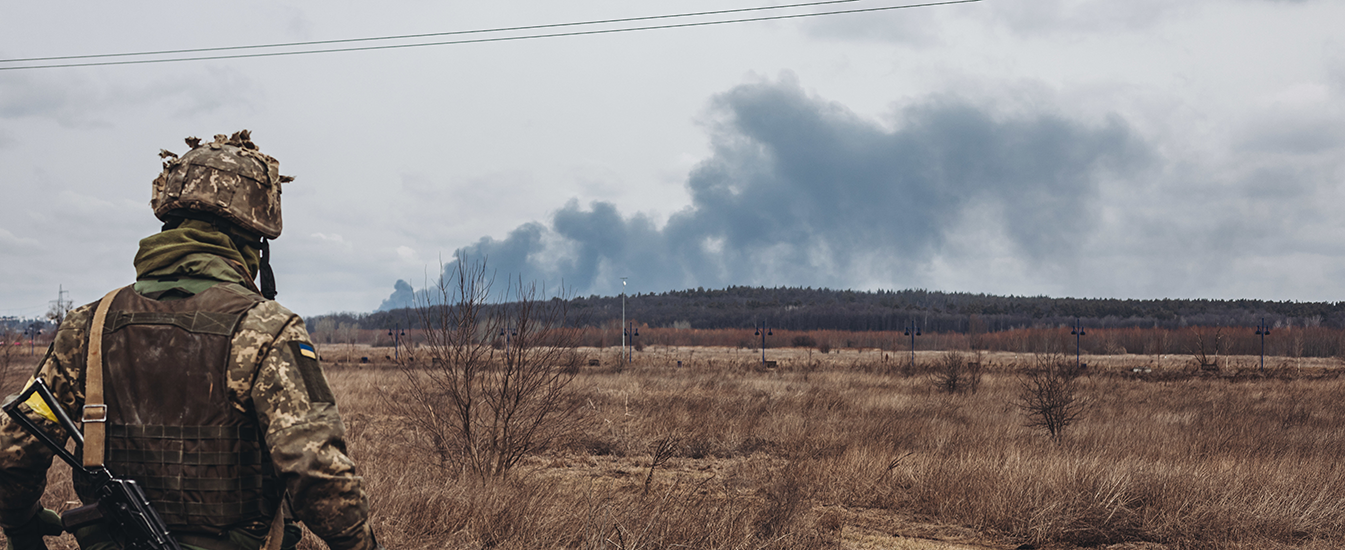An early barrage of Russian airstrikes, artillery fire and cruise missiles shook up Ukraine on the night of February 24, targeting Ukrainian military positions, navy, air force and army bases. In the northeast of the country, huge smoke plumes from burning fuel storage tankers at a nearby military airbase clouded the morning sun around Chuhuiv, as civilians rushed to their basements hiding for the shelling.
Prior to the invasion, the United States already released an bleak initial assessment, expecting that there will be as many as 50.000 civilian deaths, and millions of refugees fleeing to Europe. During the first days of the invasion, there were already hundreds of civilian casualties, often as a direct consequence of the use of explosive weapons with a wide-area effect in populated areas. Yet beyond these dire direct humanitarian consequences, a larger ecological threat awaits. Since the past 1,5 week since the outbreak of the war, PAX is monitoring the situation in Ukraine to identify potential environmental hotspots that would require urgent response or should be dealt with in the long-term. In this article we outline a couple of high and medium-risk scenarios. The locations were identified by monitoring social media reports through Telegram, Twitter, Facebook and Instagram, and geolocated for verification. Additional satellite imagery was used to visualize these impacts and further verify the locations. This alert only lists a limited number of locations, and undoubtedly more information will surface that will add to this non-exhaustive list. We welcome any input, feedback and collaboration on this topic. This is part of series of Environment and Conflict Alerts PAX is producing to identify and monitoring the environmental dimensions of armed conflict, with previous ones on Syria’s conflict-linked crop fires and oil leaks, forest fires linked with bombing campaigns in Iraq, and the environmental toll of the Gaza war in 2021.
A History of Slow Violence
Ukraine’s economy is largely built on heavy industrial activities, in particular in the east of the country, with many facilities being in poor condition due to a lack of maintenance or impact from previous attacks in the localized war that has been ongoing in the area since 2014. The landscape is plotted with thousands of industrial facilities, abandoned coal mines storing toxic and radioactive waste, and large farm cooperatives storing massive amounts of wastewater in nearby ponds.
The occupation of part of the Donbas in 2014 and subsequent stalemate with continuous artillery fire exchanges between the Ukrainian army and Russia-backed separatists brought the region to the brink of an environmental catastrophe. This was averted by hastily set-up de-escalation lines to prevent shelling of chemical factories storing hundreds-of-thousands cubical liters of toxic waste, and ongoing monitoring by the Organisation for Security and Cooperation in Europe (OSCE). According to an assessment by the Dutch government, in 2018 Ukraine produced 289.5 million tons of waste, of which 75% was produced by the mining industry. According to the Ukrainian Ministry of Environment and Natural Resources’ Strategy of National Ecological Policy , there are 23.727 potentially hazardous enterprises, of which 2987 are warehouses storing highly toxic pesticides. In the Donbas alone, a non-public report funded by the British Embassy stated that there are 4,000 potentially hazardous sites in heavily urbanized areas, home to 7 million people. The map/illustration below, produced by the OSCE in their report on the tailing industry gives an impression of the scale and spread of heavy industry in Ukraine.
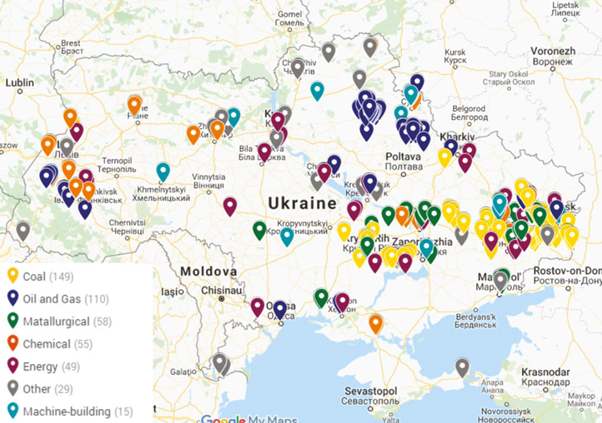
Building on open-source investigation by Bellingcat, later turned into a professional assessment by both the OSCE, civilsociety groups and humanitarianorganizations, a bleak picture was painted on the fragile environmental condition eastern Ukraine is in. With stopgap measures, the region has been walking a tight rope in the last eight years, as documented by UNICEF, with frequent shelling that continued to hit water facilities, often leaving hundreds of thousands of civilians without access to water. Damages to power infrastructure often result in water pumping system failings, putting the many mines storing toxic and nuclear waste at risks from flooding. PAX visited several high-risk locations in 2018 and discussed these concerns with factory owners, civilians and local authorities and included them into the wider advocacy and outreach work across the UN system. The current invasion is certainly going to exacerbate many existing risks, and is already creating new ones.
To understand the acute and long-term impacts we actively monitor the situation using open-source information from various Telegram channels, Twitter, Facebook and Instagram, combined with existing available data on high-risk sites and critical infrastructure, information from humanitarian organizations, supported with earth observation from a range of public and private satellites for identification and verification. The latter is certainly needed as also in this conflict, misinformation is actively spread and mistakes are easily made. One example was an alleged explosion of a munition dump on February 24, 2022 in what was said to be Kalinivka. Fact checking by Reuters however revealed that the accompanying video dated back from at least a couple of years . This example highlights the continuous need for verification and handling information with care.
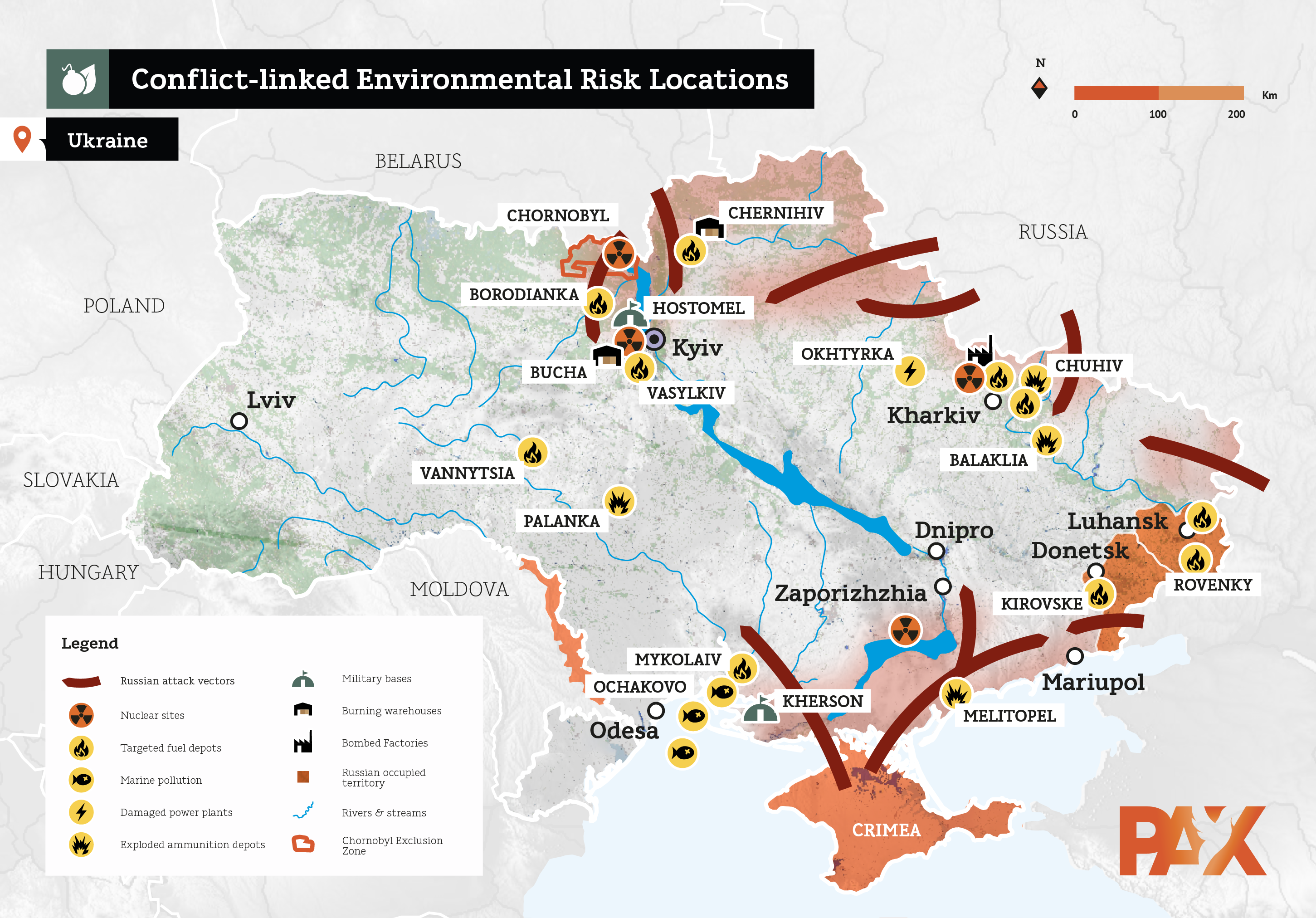
Damage to military (-linked) facilities
Attacks against a range of military facilities pose acute and long-term health risks to civilians and can pose long-term risks to the environment they depend on. We’ll briefly walk through the main vectors of pollution, namely fuel storage sites, munitions depots and military bases.
A major element in a war in a country as stretched as Ukraine is the ability to keep planes, tanks and armored vehicles running. Both parties therefore rely on fuel, and focus on taking out fuel depots close to military airports and bases to prevent access and limit enemy movement with vehicles.
Fuel storage sites
Various oil storage tankers could have duel use, with both military and civilian users, though it is unlikely that the difference matters. Russia bombed water facilities and grain storage sites in Syria, claiming them to be fuel depots, showing either a lack of military intelligence, or just deliberate targeted civilian objects.. Some are located on military bases, some in civilian areas, where the in latter case, this is posing larger public health risk to civilians in case of an explosion and subsequent fire and spills that could direct impact communities. We identified eleven oil and gas depots attacks from February 24 to March 5, 2022.
The first strike was in the night of February 24 against the fuel storage tankers at Chuhuiv airbase. The subsequent fire was captured by Planet satellite imagery. On the 26th of February, Russia bombed a fuel depot next to the airport of Mykolaiv, resulting in a huge fire and smoke plume going over a populated area. The most visible attack was the airstrike in the night of February 27 against the Vasylkiv airbase, south of Kyiv. The explosion lit up the sky at night, and the fuel tanker kept burning for a day. According to the Ukrainian Ministry of Environmental Protection and Natural Resources (MEPNR), 20.000m3 of diesel and gasoline burned up, causing air pollution over residential areas
The same night, the Ukrainian Army also launched a missile against a fuel depot of the Russia-backed separatists in Rovenky, a mining town just 50km south of Luhansk. In Kirovsky, west of the non-government controlled city of Donetsk, another alleged Ukrainian strike took place on an oil tanker farm, causing fuel leakage and a fire. An oil depot in the center of Borodianka, a small town west of Kyiv, was struck on February 28, and visible with NASA’s VIIRS satellites, while a gas facility was hit southeast of the city of Kharkiv a day earlier, which could be visually confirmed with Planet satellite imagery. On March 3, another oil tanker farm at Chernihiv was struck by Russia, causing a massive fire and smoke development in a city already under siege. The fire kept burning for days, as verified on NASA satellite imagery. Number provided by MENPNR stated that 5000m3 of fuel caught fire. On March 6, cruise missiles also hit an fuel depot at the airbase of Vynnitsia, resulting in several tankers burning down and on March 7, ballistic missiles hit a fuel depot in the city of Luhansk. And in the early morning of March 8, another strike hit fuel depots at the town of Chernyakhiv.
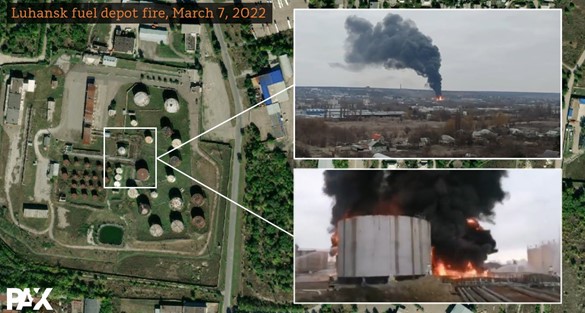
These types of attacks bring acute and long-term environmental health risks, all depending on the type of fuel and/or oil that is stored or processed, the quantity and how close the location is to populated areas and water sources. Direct public health risks are caused by air pollution from the smoke, and to first responders at the site by the fires and exposure to hazardous substances. In the long-term, leaked substances and waste water can seep into the soil or run into nearby streams, affecting surface and groundwater quality or local ecosystems.
Ammunitions and Military Remnants
Russia also targeted various ammunition depots in an attempt to deplete Ukrainian stockpiles. Such blasts and the subsequent spread of ammunition remnants can pose also acute and chronic environmental health risks from exposure to toxic munitions remnants. A growing body of scientific literature, military analysis from firing ranges and research by humanitarian deminers shed light on the risks from munitions-linked heavy metals, energetic compounds such as TNT, RDX and propellants from missiles and rockets.
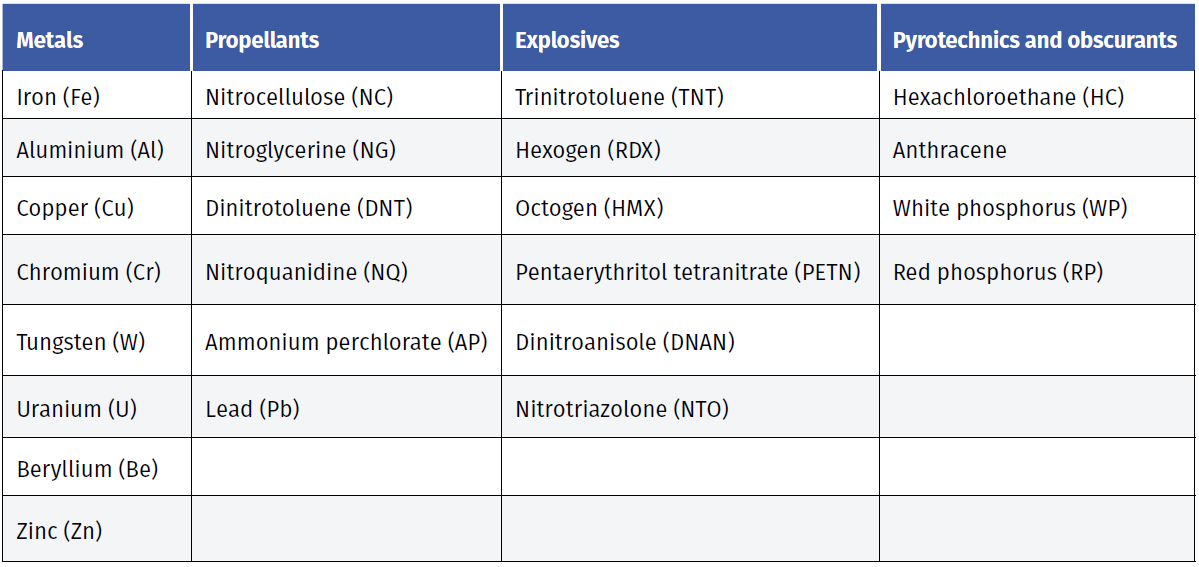
The implications of widespread conflict-pollution linked to munitions, caused by intense use of munitions in populated areas, munitions depot blasts, or post-conflict clearance work has been properly laid out by the Geneva Center for Humanitarian Demining in their latest report Guide to Explosive Ordnance Pollution of the Environment. Their analysis outlines the various pathways and vectors on how munitions can result in human exposure to hazardous substances and how this can affect ecosystems.
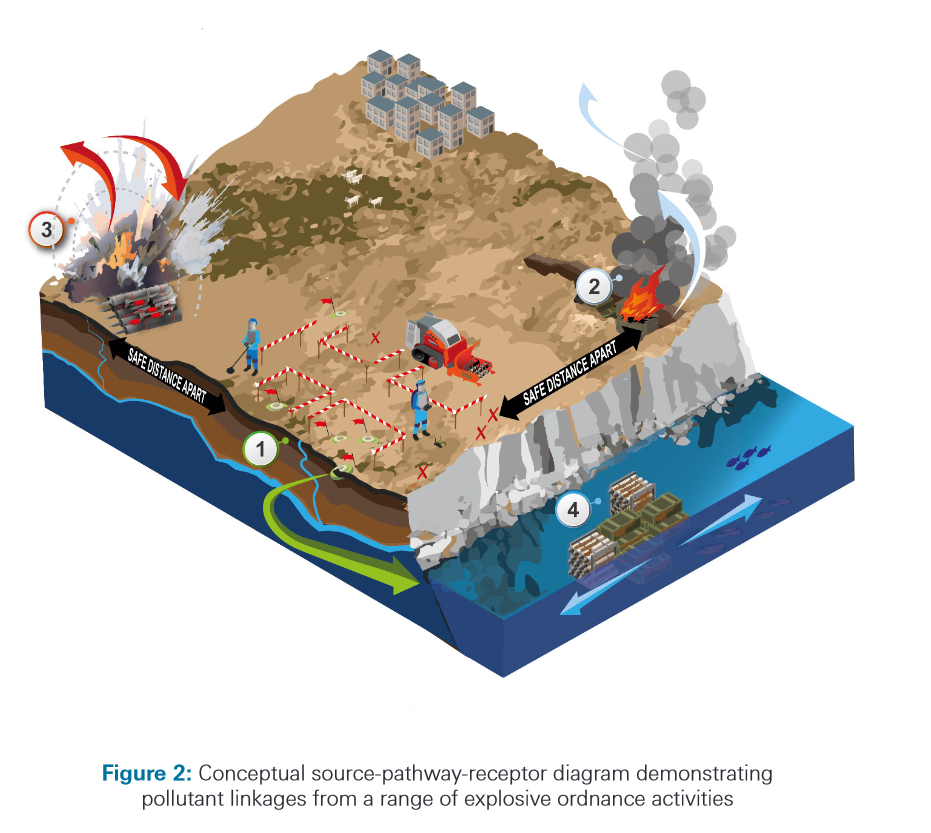
Prior to the 2022 invasion by Russia, Ukraine already witnessed several incidents around ammunitions storage depots. There were for example incidents involving drones dropping thermite bombs in Kalynivka in 2015, while two main depots exploded in 2017 in Vinnytsia and Balaklia , either caused by mismanagement or sabotage.
During the recent invasion, Russian forces also deliberately targeted at least 3 ammunition depots: one confirmed blast took place west of Palanka, a small town south of Kyiv, and other explosion again at Balaklia. Satellite imagery from Planet and Sentinel-2 shows two depots destroyed and a smoldering fire on February 26. There were other visual clues of munitions depots blown up, for example this video that describes it as an attack on the military airport at Chuhuiv, with multiple videos from local accounts confirming, though this still needs verification. There also have been a number of strikes at military bases and military airports, e.g. at Hostomel northeast of Kyiv, the military airports at Kharkiv, Vinnytsia, Chuhuiv, Mykolaiv; all military locations that are known to store a range of hazardous materials that can pose acute or long-term risks to public health and the environment.
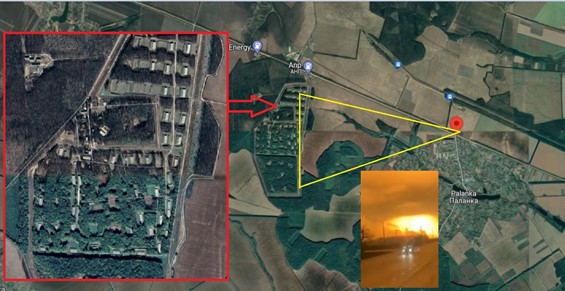
Military toxic remnants
The massive Russian deployment of armour, troops and military supplies saw dozens of kilometres of vehicles, that soon faced severe pushback from Ukrainian forces. Open-source reporting by researchers have identified upon March 8, 2022, over 1150 Russian and Ukrainian tanks, armoured vehicles, mobile rockets launchers and trucks, of which 748 have been destroyed, damaged or captured. The large numbers of remnants or abandoned/damaged Surface-to-Air (SAM) missiles and other types of missiles containing highly toxic propellants should be avoided by civilians. Military vehicles often contain a range of toxic materials, and concerns from previous conflict zones such as Iraq highlight the risks for civilians, in particular scrap workers. Civilians entering vehicles could be at risks from unexploded ordnance, while scrap metal workers stripping the vehicles can be exposed to various hazardous substance such as asbestos, PCBs and acid sources from batteries. Lastly, up till today, it remains unknown if Russia has also equipped their T-80 BVM tanks with the 125mm depleted uranium (DU) armour piercing munitions. If so, military vehicles can be contaminated with DU dust and fragments, which is classified as low-level radioactive waste and poses a health risk when inhaled or ingested.
Nuclear Sites and Critical infrastructure
The Russian invasion brought both novel and known risks to critical infrastructure, though this time with apocalyptic dimensions. There are 4 nuclear industry related sites that so far have been at risk. The take-over of the Chornobyl facility by Russia caused immediate concerns, as radiation monitoring indicated a spike in levels of various radioactive materials, though it later became clear this was caused by resuspension of soil dust in the Exclusion Zone by military movement. Still, the International Atomic Energy Agency and the Ukrainian government issued a warning as local staff on site faces psychological exhaustion and pressure that could lead to fatal mistakes. A new element in this war was the shelling of the Zaporizhzhia Nuclear Power Plant, hosting 6 of Ukraine’s 15 nuclear reactors. Projectiles fired at the nuclear facilities resulted in damage to a training center and a laboratory, and injured local staff. On February 27, Russian airstrikes nearly caused a direct hit a the RADON radioactive waste disposal site near Kyiv, while an electricity transformer linked with a similar site near Kharkiv was hit by a Russian projectile.
Critical infrastructure
Damage to critical infrastructure such as more conventional power plants and water facilities also brings direct and long-term public and environmental risks. Power plants often contain hazardous substances such as PCBS, while water filtration stations have often large quantities of chlorine store for purification, that pose acute risks. Such concerns were already flagged in 2017 by Bellingcat related to the targeting of water purification plants around Avdiivka. In the medium and long term, the lack of electricity can furthermore prevent water pumping stations from functioning, depriving people from access to clean water and creating associated communicable disease risks.
We currently have seen two incidents linked with damage to such critical infrastructure. On February 22, a power plant in Luhansk was hit after shelling, causing a fire and interruption of electricity. Another direct hit on the thermal power plant at Okhtyrka on March 3 totally destroyed the facility. There have been more reports of shelling near powerplants in Kyiv and the Trypiska power plant south of Kyiv, but these locations were reportedly not affected.
Various UN and humanitarian agencies have reported widespread damage and disruption to water infrastructure. The World Health Organisation (WHO) warned this could pose additional environmental health risks from the spread of communicable diseases, both from absence to clean water as well as broken sewage pipelines. The bombing of cities and towns likely has resulted in dozens of broken pipelines and non-functioning pumping stations, leaving hundreds of thousands of people without access to water. One clear example is the bombing near the Kyiv railway station, that shows a local water pipeline rupture.
Marine Pollution
Since the start of the invasion, Russia has also attacked various ports, Ukrainian vessels and other civilian cargo vessels bearing various flags in the Black Sea. At the port of Ochakiv, a naval depot on the seaside was targeted and burned down, while a cargo ship at Mykolaiv was hit by a missile, killing and injuring staff. A more serious pollution incident occurred east of Odessa, where two ships, the MILLENIAL SPIRIT and the NAMURA QUEEN, carrying fuel and chemicals, were hit and sank, causing a local spill that was visible with Sentinel-2 imagery, and on March 8, 2022 it was still burning, as seen on Planet Skysat imagery.
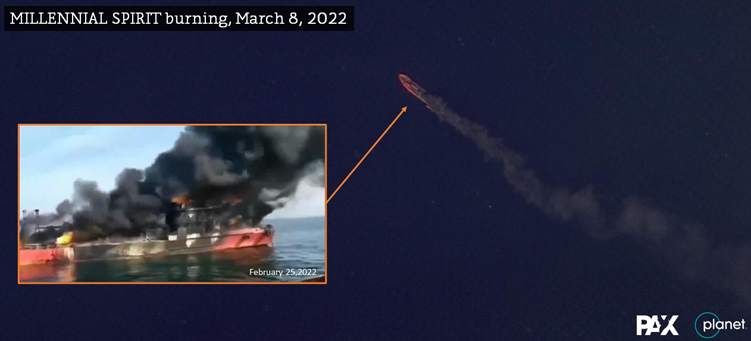
Explosive weapons in populated areas
Over the course of the invasion, Russia increasingly stepped up the targeting of populated areas with explosive weapons, including multiple rocket launch systems, both with unitary as well as cluster munition payload, heavy-long range cruise missiles and ballistic missiles. There are already over 1200 civilian casualties, with 406 civilians killed, a figure that is likely much higher as civilian deaths and injuries continue to be verified. The use of explosive weapons with wide area effects poses an unacceptable risk to civilians, both directly and indirectly, when used in populated areas. On the long term there could be additional health and environmental impacts from the use of explosive weapons in towns and cities, as PAX has outlined in this article on Exploring environmental harm from explosive weapons in populated areas. Civilians residing in affected areas could face sustained exposure from inhaling fine dust caused by pulverized building materials, often mixed with heavy metals and other hazardous substances. Damage to environmental infrastructure in the cities further can result in exposure to other pollution pathways and contamination sources.
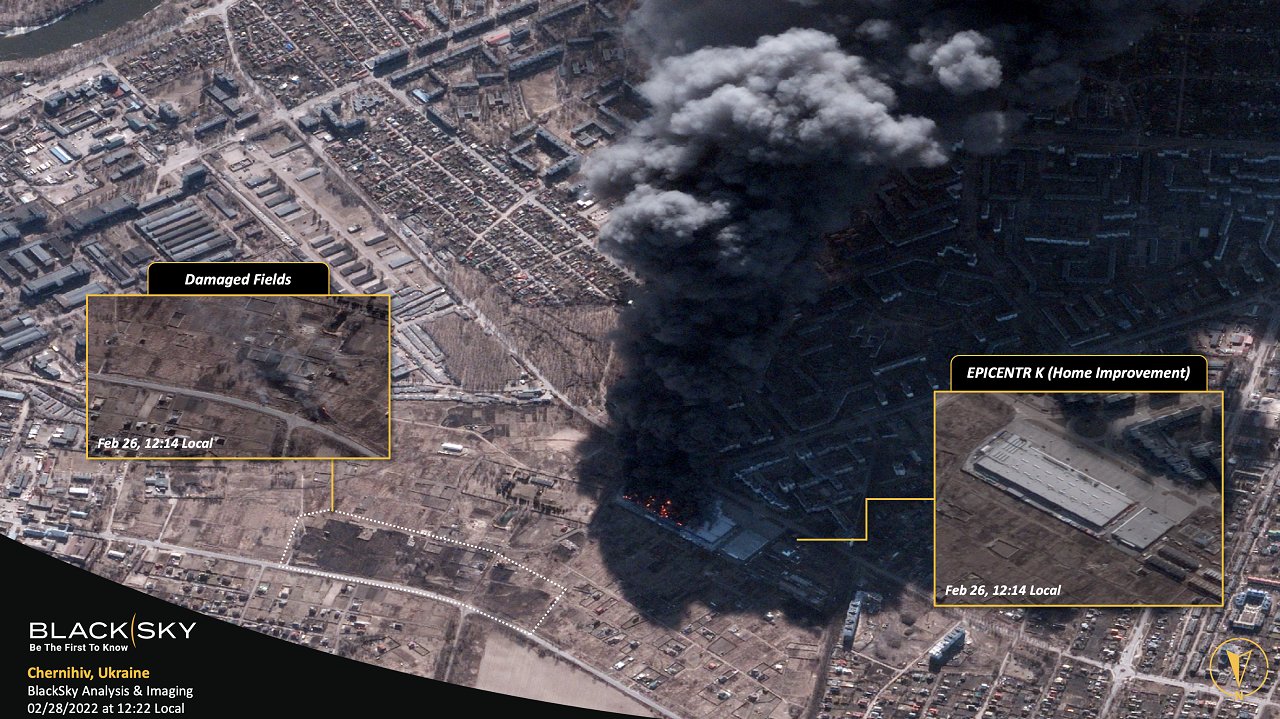
Factories and warehouses
A number of fires and damage to locations storing or processing hazardous materials was further observed, including the Malyshev tank factory in Kharkiv and another tank factory in Zhytomyr; a large warehouse in the western district of Kyiv used for storage and assembly of foam, a pharmaceutical warehouse in Stoyanka also west of Kyiv and a home improvement warehouse in Chernihiv, causing a huge fire and heavy smoke development, which was captured by the commercial satellite provider BlackSky. It is expected that many more small factories and workshops in and outside urban areas have been damage and destroyed. Another warehouse storing chemicals caught fire on March 7 after a ballistic missile was shot down in Kalynikva, west of Kyiv.
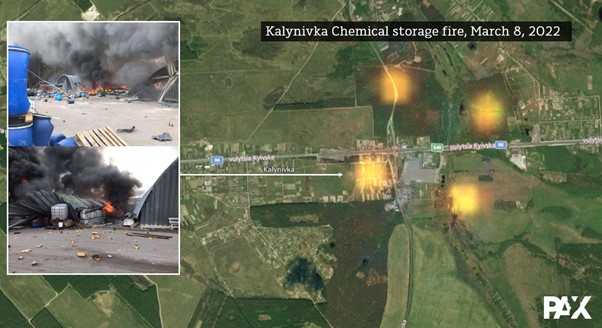
Future outlook – Monitoring and Environmental Governance.
There are a number of high-risk scenarios from the ongoing war that require permanent monitoring. In particular the risks of an incident around nuclear reactors or radioactive waste storage facilities remain high. As Russia is closing in on major cities such as Kharkiv, Mariupol and Kyiv, all with heavy industrial zones that include chemical factories, metallurgies, toxic waste ponds and other production and storage sites with hazardous substances, a catastrophic environmental emergency remains probable. In the east, the situation in the Donbas requires special attention as the various abandoned mines storing toxic and radioactive waste are now even more at risk from flooding with severe disruptions in electricity production.
The collapse of environmental governance in urban areas will in the immediate and long term also pose serious problems with solid waste collection and disposal that could contribute to further public health and environmental risks.
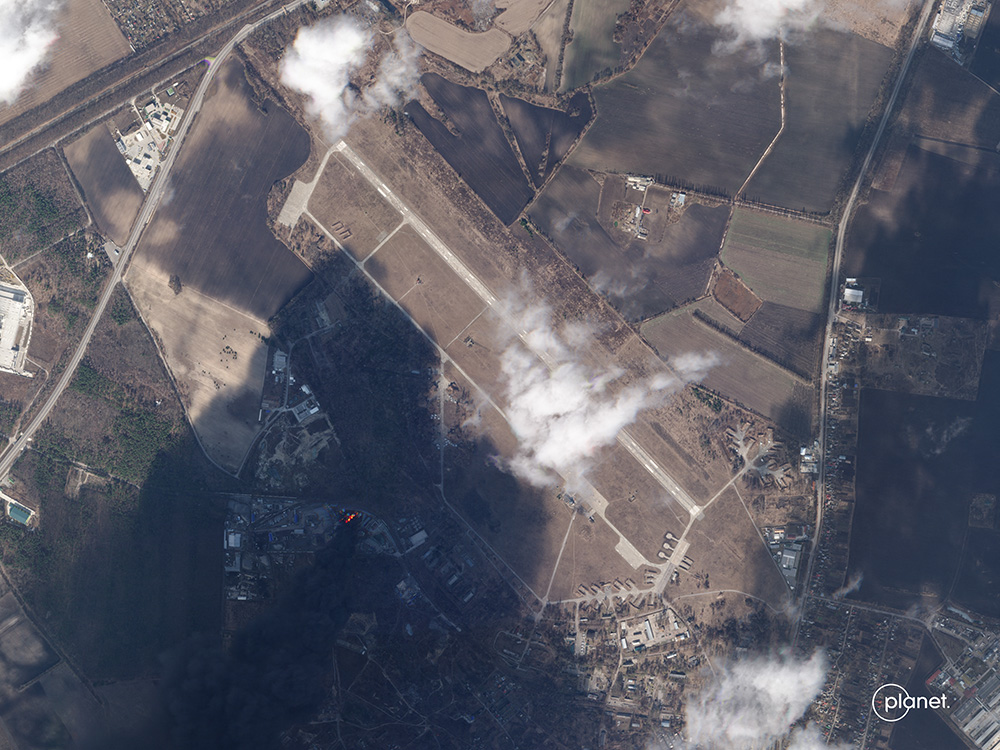
In the long term, it will be of major importance that the necessary equipment, expertise and funding to properly identify, monitor and remediate environmental hotspots will be made available or restored. Enforcement of environment regulations to prevent and minimize environmental risks will be pivotal to protect people and their environment in Ukraine.
From the 28th of February to March 3rd, the fifth United Nations Environment Assembly met in Nairobi, where the war in Ukraine turned out to be a contentious issue for States. A joint statement by 108 civil society organisations urged Member States and UNEP to already explore opportunities to identify and monitor environmental impacts in collaboration with experts and civil society groups. A wider initiative by the Environmental Peacebuilding Association had more than 1000 experts and NGOs worldwide to sign-up for call to the international community to address the environmental dimensions of the war in Ukraine.
In 2016, UNEA-2 adopted a Ukrainian resolution on the protection of the environment in areas affected by armed conflict. The necessity of this was reiterated in 2017, when UNEA-3 adopted an Iraqi-led resolution on conflict-pollution that paved to way for initial assessment and support of clean-up in Iraq. PAX calls upon States to again implement UNEA resolution 2.15 and 3/1 to pro-actively dedicate funding and expertise to UNEP, support Ukrainian environmental civil society organisations and ministries with their work on documenting environmental concerns and support mainstreaming environment into humanitarian response and reconstruction efforts.

